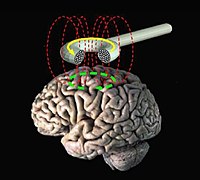
Photo from wikipedia
Objective High-frequency repetitive transcranial magnetic stimulation (HF-rTMS) has been proposed as a promising therapeutic intervention for patients with disorders of consciousness (DOC). However, its therapeutic effects in the literature are… Click to show full abstract
Objective High-frequency repetitive transcranial magnetic stimulation (HF-rTMS) has been proposed as a promising therapeutic intervention for patients with disorders of consciousness (DOC). However, its therapeutic effects in the literature are inconsistently documented. The primary aim of this study was to explore the alterations in neural connectivity and neurobehavioral reactivity during rTMS modulation in patients with DOC. In addition, safety was investigated as a secondary aim. Methods The presence of bilateral N20 components in DOC patients was determined by somatosensory-evoked potential (SEP) before enrollment in the study. A total of 64 patients were enrolled and randomly placed into the active and sham groups. Ultimately, 50 patients completed the study. Twenty-five patients in the active group underwent real HF-rTMS, and 25 patients in the sham group underwent sham HF-rTMS, which was delivered over the left dorsolateral prefrontal cortex (DLPFC). The outcome measures of performed pre- and postintervention included the latencies of the N20 and N20-P25 amplitudes of SEP, brainstem auditory-evoked potential (BAEP) grade, JFK Coma Recovery Scale-Revised (CRS-R) score, and Glasgow Coma Scale (GCS) score; any adverse events were recorded at any time during the intervention. Result Following six weeks of treatment, a significant increase was observed in the total CRS-R and GCS scores, and the N20-P25 amplitudes of patients in the two groups were compared with that obtained from preintervention (all p values < 0.05). The waves of BAEP in the two groups also showed a trend toward normalized activity compared with preintervention grades (p values < 0.05). A significant decrease in the latencies of N20 (p values < 0.001) was observed in the active group compared with measurements obtained from preintervention, whereas no significant decrease was observed in the sham group (p values = 0.013). The improvement in total CRS-R scores (p values = 0.002), total GCS scores (p values = 0.023), and N20-P25 amplitudes (p values = 0.011) as well as the decrease in latencies of N20 (p values = 0.018) and change in BAEP grades (p values = 0.013) were significantly different between the two groups. The parameters in neural connectivity (N20-P25 amplitudes, N20 latencies, and BAEP grades) were significantly correlated with the total CRS-R and GCS scores at postintervention, and the changes of CRS-R before and after interventions have a positive relationship with N20-P25 amplitudes. No adverse events related to the rTMS protocol were recorded. Conclusion Neural connectivity levels are affected by HF-rTMS and are significantly related to clinical responses in DOC patients with the presence of bilateral N20. The elevation of neural connectivity levels may lay a foundation for successful HF-rTMS treatment for DOC patients.
Journal Title: Neural Plasticity
Year Published: 2022
Link to full text (if available)
Share on Social Media: Sign Up to like & get
recommendations!